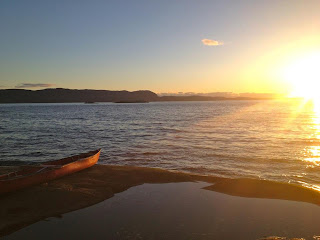The other day I found myself staring at a rough topo for the mega project Rob and Colin put up on the West Main Wall in the Eldred ten years ago and thinking to myself, "Jesus Christ."
This is a seriously bad ass route. There are two reasons for this. A) It was the first ascent of the West Main Wall. B) It was done with style, and it's hard. We're talking pitches of A3 and an intimidating sounding pitch of A4+. For those of you who don't know how Aid climbing grades work, A3 is right around where things start to get serious.
 |
| Unknown climber on Pysche Slab, West Main Wall in background - Unknown |
Allow me to copy and paste a detailed explanation of the grade.
'
A3: Hard aid: testing methods required. Involves many tenuous placements in a row. Generally solid placements (which could hold a fall) found within a pitch. Long fall potential up to 50 feet (6-8 placements ripping), but generally safe from serious danger. Usually several hours required to complete a pitch, due to complexity of placements. Examples: The Pacific Ocean Wall lower crux pitches (30 feet between original bolts on manky fixed copperheads), Standing Rock in the desert (the crux being a traverse on the first pitch with very marginal gear with 30 foot swing potential into a corner).'
But wait! There's more! Following is a slightly less strenuous A2 pitch, some moderate free climbing, and then the ominous A4+ pitch that brings them into The Arch of Time, the striking arch feature smack dab in the middle of the mainer.
Here's how A4+ is described'
 |
| Rob (or is it Colin?) leading the 5.10+ fifth pitch |
'A4+: More serious than A4. these leads generally take many hours to complete and require the climber to endure long periods of uncertainty and fear, often requiring a ballet-like efficiency of movement in order not to upset the tenuous integrity of marginal placements. Examples: the "Welcome to Wyoming" pitch (formerly the"Psycho Killer" pitch) on the Wyoming Sheep Ranch on El Cap, requiring 50 feet of climbing through a loose, broken, and rotten Diorite roof with very marginal, scary placements like stoppers wedged in between two loose, shifting, rope-slicing slivers of rock, all this over a big jagged loose ledge which would surely break and maim bones. The pitch is then followed by 100 feet of hooking interspersed with a few rivets to the belay.'
 And that's not all folks...immediately after this comes the last A3 pitch of the route, through the very steep looking arch of Time. A feature that begs to be climbed.
And that's not all folks...immediately after this comes the last A3 pitch of the route, through the very steep looking arch of Time. A feature that begs to be climbed.
Below is a teaser from an article I found written by the late Colin Dionne himself. I never knew this existed and am really excited to find a written version of his story. It can't compare to the times I've heard him tell stories of this epic over the fire in the Eldred, with such intense passion, re-enactments, sound effects, and rumbling laughter that came with all of Colin's stories - but it's detailed and first hand, and I'm happy to be able to share it.
"The classic first ascent of the formation The West Main Wall. This 18 pitch mixed aid/free project was completed capsule style by Rob Richards and Colin Dionne in 1993, following an epic retreat in 1992. The epitome of good style this hard core route still awaits a repeat. Only eighteen bolts were used, many of them quarter inchers. Definitely not a route for the faint of heart!
When Rob Richards and I set out to climb the West Main Wall, we were possessed with a desire to meet the wall head on. Our equipment and techniques were for the most part antiquated, having been cultured from the collected works of Royal Robbins and "Batso" Harding. The spring of ’92 had been fruitful, the Lake bluffs had already seen 30 new routes put up by Rob and I. We were strong. We had no Idea of the scope of our desire.
We began fixing ropes in mid May. The first pitch fell to Rob who easily dispatched the easy left facing corner (5.7). I climbed up to the large edge Rob was belaying on and called it an l-edge. I then set out on the second pitch, which was more left facing corner. This pitch found me lay-backing 5.10 while digging vigorously with the pick of my hammer to unearth finger locks. Occasional pro and no falls got me to the small sloping feature that became the second belay (5.10). I hand drilled the first bolt on the route to back up the scattered mank that made up the rest of the belay. The first two pitches fixed, we returned to town.
The third pitch started the fun, the corner became much steeper, and the crack became thinner. Many knife blades and RPs later Rob finally fixed the third with a two and a half bolt anchor (5.9A3). Two weekends were spent on this pitch, both involving rainouts on Sunday. On our next foray I sent the fourth pitch after a long day of..."(To be continued!)
Stay tuned for the rest of the story in another post. (I found it on a site where I have to pay for the rest...which I can't do right now due to an issue with my PayPal account, but I will post the rest when I can!)
Also coming soon, the story of the first ascent of Carag Dur...a very impressive, very hard aid route.

















